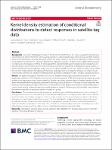Kernel density estimation of conditional distributions to detect responses in satellite tag data
| dc.contributor.author | Hewitt, J | |
| dc.contributor.author | Gelfand, AE | |
| dc.contributor.author | Quick, NJ | |
| dc.contributor.author | Cioffi, WR | |
| dc.contributor.author | Southall, BL | |
| dc.contributor.author | DeRuiter, SL | |
| dc.contributor.author | Schick, RS | |
| dc.date.accessioned | 2023-11-28T13:04:27Z | |
| dc.date.available | 2023-11-28T13:04:27Z | |
| dc.date.issued | 2023-09-27 | |
| dc.identifier.issn | 2050-3385 | |
| dc.identifier.issn | 2050-3385 | |
| dc.identifier.other | 28 | |
| dc.identifier.uri | https://pearl.plymouth.ac.uk/handle/10026.1/21732 | |
| dc.description.abstract |
Background As levels of anthropogenic noise in the marine environment rise, it is crucial to quantify potential associated effects on marine mammals. Yet measuring responses is challenging because most species spend the majority of their time submerged. Consequently, much of their sub-surface behavior is difficult or impossible to observe and it can be difficult to determine if—during or following an exposure to sound—an observed dive differs from previously recorded dives. We propose a method for initial assessment of potential behavioral responses observed during controlled exposure experiments (CEEs), in which animals are intentionally exposed to anthropogenic sound sources. To identify possible behavioral responses in dive data collected from satellite-linked time–depth recorders, and to inform the selection and parameters for subsequent individual and population-level response analyses, we propose to use kernel density estimates of conditional distributions for quantitative comparison of pre- and post-exposure behavior. Results We apply the proposed method to nine Cuvier’s beaked whales (Ziphius cavirostris) exposed to a lower-amplitude simulation of Mid-Frequency Active Sonar within the context of a CEE. The exploratory procedure provides evidence that exposure to sound causes animals to change their diving behavior. Nearly all animals tended to dive deep immediately following exposure, potentially indicating avoidance behavior. Following the initial deep dive after exposure, the procedure provides evidence that animals either avoided deep dives entirely or initiated deep dives at unusual times relative to their pre-exposure, baseline behavior patterns. The procedure also provides some evidence that animals exposed as a group may tend to respond as a group. Conclusions The exploratory approach we propose can identify potential behavioral responses across a range of diving parameters observed during CEEs. The method is particularly useful for analyzing data collected from animals for which neither the baseline, unexposed patterns in dive behavior nor the potential types or duration of behavioral responses is well characterized in the literature. The method is able to be applied in settings where little a priori knowledge is known because the statistical analyses employ kernel density estimates of conditional distributions, which are flexible non-parametric techniques. The kernel density estimates allow researchers to initially assess potential behavioral responses without making strong, model-based assumptions about the data. | |
| dc.format.extent | 28- | |
| dc.language | en | |
| dc.publisher | Springer Science and Business Media LLC | |
| dc.subject | Discrepancy statistics | |
| dc.subject | Kernel density estimator | |
| dc.subject | Tail probability | |
| dc.subject | Pre- and post-data windows | |
| dc.subject | Summary statistics | |
| dc.subject | Time-series | |
| dc.subject | Behavioral response | |
| dc.title | Kernel density estimation of conditional distributions to detect responses in satellite tag data | |
| dc.type | journal-article | |
| dc.type | Article | |
| plymouth.author-url | https://www.webofscience.com/api/gateway?GWVersion=2&SrcApp=PARTNER_APP&SrcAuth=LinksAMR&KeyUT=WOS:000860575100001&DestLinkType=FullRecord&DestApp=ALL_WOS&UsrCustomerID=11bb513d99f797142bcfeffcc58ea008 | |
| plymouth.issue | 1 | |
| plymouth.volume | 10 | |
| plymouth.publication-status | Published online | |
| plymouth.journal | Animal Biotelemetry | |
| dc.identifier.doi | 10.1186/s40317-022-00299-7 | |
| plymouth.organisational-group | |Plymouth | |
| plymouth.organisational-group | |Plymouth|Faculty of Science and Engineering | |
| plymouth.organisational-group | |Plymouth|Faculty of Science and Engineering|School of Biological and Marine Sciences | |
| plymouth.organisational-group | |Plymouth|REF 2021 Researchers by UoA | |
| plymouth.organisational-group | |Plymouth|Users by role | |
| plymouth.organisational-group | |Plymouth|Users by role|Academics | |
| plymouth.organisational-group | |Plymouth|REF 2021 Researchers by UoA|UoA07 Earth Systems and Environmental Sciences | |
| plymouth.organisational-group | |Plymouth|REF 2028 Researchers by UoA | |
| plymouth.organisational-group | |Plymouth|REF 2028 Researchers by UoA|UoA07 Earth Systems and Environmental Sciences | |
| dcterms.dateAccepted | 2023-08-17 | |
| dc.date.updated | 2023-11-28T13:04:26Z | |
| dc.rights.embargodate | 2023-12-8 | |
| dc.identifier.eissn | 2050-3385 | |
| rioxxterms.versionofrecord | 10.1186/s40317-022-00299-7 |


